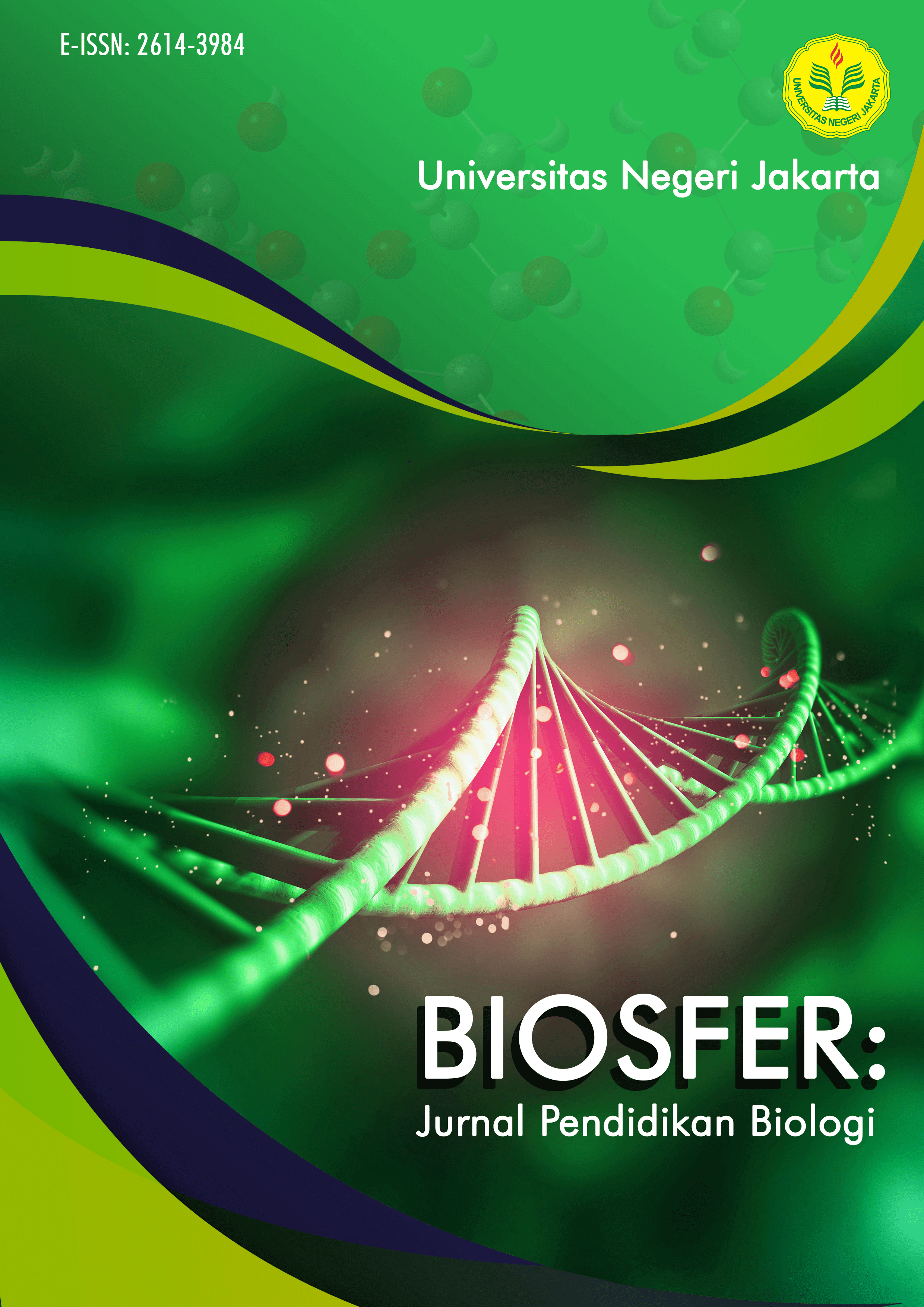Correlation between belief in science and belief in pseudoscience in high school students
DOI:
https://doi.org/10.21009/biosferjpb.37447Keywords:
Biology, Media Literacy, Pseudoscience, Science trustAbstract
Dissemination of news through social media is one of the biggest causes of increasing student’s trust in pseudoscience. The purpose of this correlational study was to analyze the relationship between belief in science and pseudoscience beliefs related to biology in high school students. This research entails a correlational study conducted through a survey methodology. The results of the study show that the ability to believe in science has a significant effect on students' belief in pseudoscience related to biology for high school students. Based on the research, the initial hypothesis of the study was rejected, that there is a positive relationship between belief in science and belief in pseudoscience related to biology, thus indicating that increasing students' confidence in science will also increase students' confidence in pseudoscience related to biology. This is due to the continuous spread of unscientific issues through social media which will affect the increase in trust in pseudoscience. The increase in pseudoscience is due to the lack of student media literacy so that it can affect the way students respond to news that is on social media. The lack of education regarding students' media literacy is a factor in increasing students' confidence in pseudoscience related to biology for high school students.
References
Ayun, Q. (2017). Pola asuh orang tua dan metode pengasuhan dalam membentuk kepribadian anak. ThufuLA: Jurnal Inovasi Pendidikan Guru Raudhatul Athfal, 5(1), 102. https://doi.org/10.21043/thufula.v5i1.2421
Azizah, N., & Alberida, H. (2021). Seperti apa permasalahan pembelajaran biologi pada siswa SMA ? Journal for Lesson and Learning Studies, 4(3), 388–395. https://ejournal.undiksha.ac.id/index.php/JLLS%0ASeperti
Benjamin, K. A., & McLean, S. (2022). Change the medium, change the message: creativity is key to battle misinformation. Advances in Physiology Education, 46(2), 259–267. https://doi.org/10.1152/advan.00021.2021
Candra, R., & Hidayati, D. (2020). Penerapan praktikum dalam meningkatkan keterampilan proses dan kerja peserta didik di laboratorium IPA. Edugama: Jurnal Kependidikan Dan Sosial Keagamaan, 6(1), 26–37. https://doi.org/10.32923/edugama.v6i1.1289
Claassen, G. (2021). The viral spreading of pseudoscientific and quackery health messages on twitter – finding a communication vaccine. Current Allergy and Clinical Immunology, 34(1), 18–22. https://doi.org/10.520/ejc-caci-v34-n1-a4
Farias, M., Newheiser, A. K., Kahane, G., & de Toledo, Z. (2013). Scientific faith: Belief in science increases in the face of stress and existential anxiety. Journal of Experimental Social Psychology, 49(6), 1210–1213. https://doi.org/10.1016/j.jesp.2013.05.008
Hendriks, F., Kienhues, D., & Bromme, R. (2016). Trust in science and the science of trust. February, 143–159. https://doi.org/10.1007/978-3-319-28059-2_8
Hidayat, F. P., Hardiyanto, S., Lubis, F. H., Adhani, A., & Zulfahmi. (2023). Kemampuan literasi media sebagai upaya mengantisipasi cybercrime pada remaja di Kota Medan. Jurnal Interaksi: Jurnal Ilmu Komunikasi, 7(1), 13–25. http://dx.doi.org/10.30596%2Finteraksi.v7i1.12094
Krüger, J. T., Höffler, T. N., & Parchmann, I. (2022). Trust in science and scientists among secondary school students in two out-of-school learning activities. International Journal of Science Education, Part B: Communication and Public Engagement, 12(2), 111–125. https://doi.org/10.1080/21548455.2022.2045380
Metin, D., Cakiroglu, J., & Leblebicioglu, G. (2020). Perceptions of eighth graders concerning the aim, effectiveness, and scientific basis of pseudoscience: The case of crystal healing. Research in Science Education, 50(1), 175–202. https://doi.org/10.1007/s11165-017-9685-4
Milasari, M., Badarussyamsi, B., & Syukri, a. (2021). filsafat ilmu dan pengembangan metode ilmiah. Jurnal Filsafat Indonesia, 4(3), 167–179. https://doi.org/10.33487/mgr.v3i1.3932
Ningrum, M. S., Lengkana, D., & Yolida, B. (2019). Analisis keterlaksanaan praktikum biologi sekolah menengah atas swasta se-Kotamadya Bandar Lampung. Jurnal Bioterdidik, 7(2), 56–65. http://jurnal.fkip.unila.ac.id/index.php/JBT/article/view/17262
Peña, A., & Paco, O. (2004). Attitudes and views of medical students toward science and pseudoscience. Medical Education Online, 9(1), 4347. https://doi.org/10.3402/meo.v9i.4347
Saputra, J. ., Adiprasetio, J., & Kusmayadi, I. (2015). World without secret. Jurnal Pengabdian Kepada Masyarakat, 2(3), 1–3. https://jurnal.unpad.ac.id/pkm/article/view/19903/9564
Sari, Y., & Prasetya, D. H. (2022). Literasi Media Digital Pada Remaja, Ditengah Pesatnya Perkembangan Media Sosial. Jurnal Dinamika Ilmu Komunikasi, 8(1), 12–25. http://journal.moestopo.ac.id/index.php/dinamika%0A12
Solloway, A. (2020). Public attitudes to science. Science and Public Policy. https://doi.org/10.1093/spp/4.1.38
Supratmn, & Abdullah, Z. . (2020). Permasalahan dalam komunikasi sains. Global Komunika, 1(2), 76–86. https://ejournal.upnvj.ac.id/index.php/GlobalKomunika/article/download/2321/1115
Swami, V., Stieger, S., Pietschnig, J., Nader, I. W., & Voracek, M. (2012). Using more than 10% of our brains: Examining belief in science-related myths from an individual differences perspective. Learning and Individual Differences, 22(3), 404–408. https://doi.org/10.1016/j.lindif.2011.12.005
Ulfa, S. W. (2018). Mentradisikan sikap ilmiah dalam pembelajaran biologi. Jurnal Biolokus, 1(1), 1. https://doi.org/10.30821/biolokus.v1i1.314
Wahyuningsih, B. Y., & Sunni, M. A. (2020). Efektifitas penggunaan otak kanan dan otak kiri terhadap pencapaian hasil belajar mahasiswa (studi kasus pada mahasiswa Program Studi Sistem Informasi Stmik MataraM). Palapa, 8(2), 351–368. https://doi.org/10.36088/palapa.v8i2.885
Wulandari, F. E. (2016). Pengaruh model pembelajaran berbasis proyek untuk melatihkan keterampilan proses mahasiswa. Pedagogia : Jurnal Pendidikan, 5(2), 247–254. https://doi.org/10.21070/pedagogia.v5i2.257
Downloads
Published
How to Cite
Issue
Section
License
The Authors submitting a manuscript do so on the understanding that if accepted for publication, copyright of the article shall be assigned to Biosfer: Jurnal Pendidikan Biologi (Biosferjpb) and Departement of Biology Education, Universitas Negeri Jakarta as publisher of the journal.



